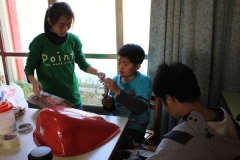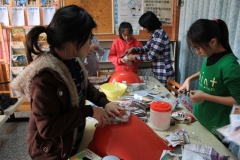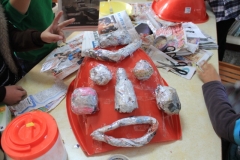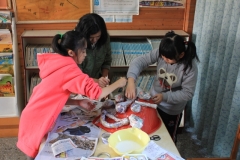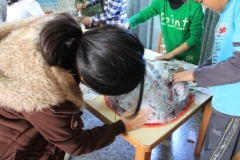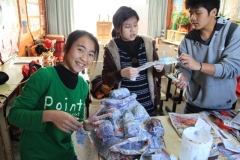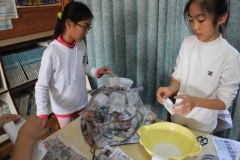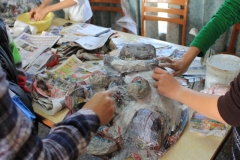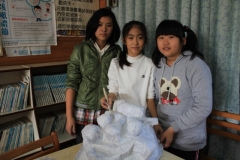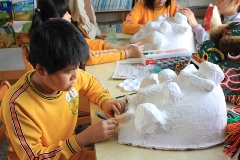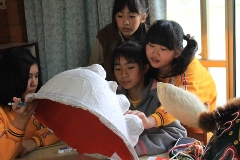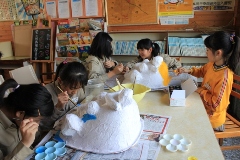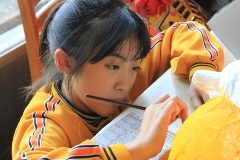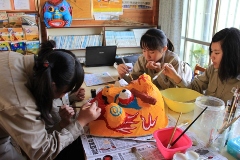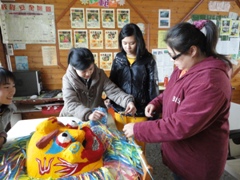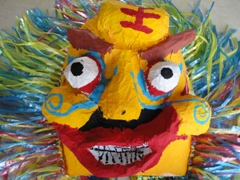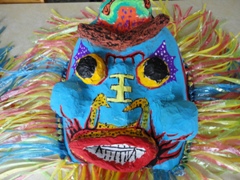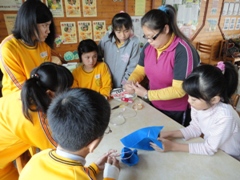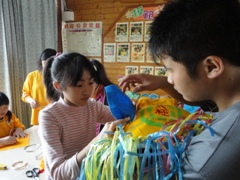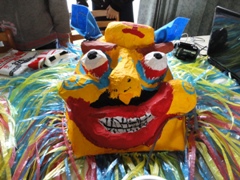











| Classical lion |
| The making of lion heads |
| Practicing lion dance |
| The Samba Lion |
| Producing Lion Masks |
| Practicing for Street Parades |
| eBook |
| The Lion Headpiece Master |
| The Xiluo Street Parade |
| Classical lion-The making of lion heads | ||||||
After visiting the old master who makes lion heads, we were very interested in how to make traditional lion heads and wanted to try to make them ourselves. So we asked Teacher Lin to teach us to make classical lion heads, and the necessary materials are: dustpan, newspaper, rice paper, clear sticky tape, white glue, brush, watercolor brush, advertising paint, plastic rope, non-woven cloth, and wire. The production process is as follows: |
||||||
1. Using the newspaper to form the facial features Teacher Lin says that the lion’s face is the same as human features, with the nose at the center, and with left-right symmetry of the eyebrows, eyes, and cheeks. Thus, when making the lion head, we have to use the newspaper to shape a nose, and fixed on the center point of the dustpan, then tie it tightly with tape. After fixing the nose, use the newspaper to make two spheres, tied with tape, fixed to the two sides of the nose to make eyes. Above the eyes are the eyebrows. For eyebrows, shape the newspaper into long strips, curved into an eyebrow shape. You can make the shape of the eyebrows on your own, turn them up or down are both fine. Then make the mouth by rolling newspapers into long pieces to encircle the mouth. Notice that there has to be room inside the mouth so one can draw the teeth. Then make the cheeks by using the newspaper to shape the cheeks, fixed on the two sides of the nose. Make sure the two sides are symmetrical. Finally, mold a long strip, tied with many layers of tape, to make the lion’s forehead. Teacher Lin says that when using the newspapers to make the features of the lion, it is necessary to take care to see if the newspapers are closely wrapped. If the center is hollow, it would affect later steps. When pasting the newspaper, the bone structure of the lion head would cave in and would not seem solid. |
||||||
|
||||||
| 2. Wet the newspaper and paste it on layer by later
After shaping the facial features of the lion head, we tear newspaper into long strips, use white paste and water, then brush on the glue on the dustpan. Now, careful! The air has to be brushed out so that it is smooth, and the newspaper strips have to be overlapping without space. The pieces of newspaper cannot be too big, and it has to be fully wet, to make sure that it can be pasted over the facial features. Repeat the steps above and make several layers, and now the bottom layer of the lion head is made. |
||||||
|
||||||
| 3. Paste rice paper as the bottom layer for coloring
After pasting the newspaper, tear rice paper into long strips, make them wet and paste on the layers until the newspapers cannot be seen at all. Then wait for it too dry completely, so it can be colored. |
||||||
|
||||||
| 4. Composition design before coloring
Before coloring, Teacher Lin let us see the images on the lion’s head, which are all left-right symmetrical. The teacher told us that when we are drawing on the lion head, it is also necessary to make sure they are right-left symmetrical. The compositions look easy but they are difficult to draw. Since the lion heads are three-dimensional, and they are not as easy as two-dimensional. It took us about an hour to draw them to look like this. |
||||||
|
||||||
| 5. Coloring
Then, we color the drafted lion heads, Teacher Lin told us to first think about the color before we apply it. If the base color is yellow, then it is all right to first start with the base color then fill out the details. If the base color is another color, it would be necessary to first fill in the details then apply the base color. In addition, it is also necessary to take care to see if the colors are contrasting or similar, and they cause different feelings after coloring. At first, we did not think that coloring is too difficult, but if the wrinkles made it difficult to paint. Also, for the areas with white glue, advertising paint would not work either. Thus, it is necessary to not add water and fill on the layers so the colors are smooth. After two days, at least we were able to gradually fill out the two lion heads. Seeing them gradually come together, the colors were very bright and we felt such a sense of accomplishment! |
||||||
|
||||||
| 6. Making the mane
After the lion head colors were fully dry, we asked Teacher Chen Jialin to teach us how to tie the mane. We used plastic rope to tie the mane. First we prepared long rope as the base rope, then cut the rope into pieces, tied on the long rope, and finally we used white glue to paste on the lion head. To make our lion mane bright and ostensible, we used colorful plastic rope, and decided not to tear it thinner, because after tearing it open, the plastic rope has translucent color and would be less bright! |
||||||
|
||||||
| 7. Add the ears
The final step is adding ears to the lion heads. We use wire to coil into an ear shape, and then use cloth to create the form, then paste it with white glue to complete. |
||||||
|
||||||
| Reflections on the activity
Huiyu Cheng: I think that the most fun and easy part was pasting the newspaper and rice paper. When I put my hand into the white glue, everyone was shouting about how much fun it is. It’s cold and sticky, comfortable to the touch. When we are sticking on the rice paper, someone said it’s like putting a facial mask on the lion head, it was so much fun! Shaotang Cheng: the event was a lot of fun. Even though I have an injured arm so I could not participate in making the lion head, and could only record the event, I heard the laughter of other team members in the process, and I also felt the fun of making lion heads. |
||||||

